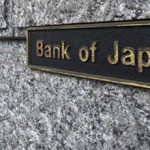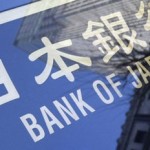Bank of Japan:Statement on Monetary Policy

- At the Monetary Policy Meeting (MPM) held today, the Policy Board of the Bank of Japan decided upon the following.
(1) Quantity Dimension: The guideline for money market operations
The Bank decided, by an 8-1 majority vote, to set the following guideline for money market operations for the intermeeting period:[Note 1]
The Bank of Japan will conduct money market operations so that the monetary base will increase at an annual pace of about 80 trillion yen.
(2) Quality Dimension: The guidelines for asset purchases
With regard to the asset purchases, the Bank decided, by an 8-1 majority vote, to set the following guidelines:[Note 1]
a) The Bank will purchase Japanese government bonds (JGBs) so that their amount outstanding will increase at an annual pace of about 80 trillion yen. With a view to encouraging a decline in interest rates across the entire yield curve, the Bank will conduct purchases in a flexible manner in accordance with financial market conditions. The average remaining maturity of the Bank’s JGB purchases will be about 7-12 years.
b) The Bank will purchase exchange-traded funds (ETFs) so that their amount outstanding will increase at an annual pace of about 3 trillion yen until the end of March 2016 and, from April, at an annual pace of about 3.3 trillion yen.1 It will also purchase Japan real estate investment trusts (J-REITs) so that their amount outstanding will increase at an annual pace of about 90 billion yen.
c) As for CP and corporate bonds, the Bank will maintain their amounts outstanding at about 2.2 trillion yen and about 3.2 trillion yen, respectively.
(3) Interest-Rate Dimension: The policy rate
- The Bank decided, by a 7-2 majority vote, to continue applying a negative interest rate of minus 0.1 percent to the Policy-Rate Balances in current accounts held by financial institutions at the Bank.[Note 2]Japan’s economy has continued its moderate recovery trend, although exports and production have been sluggish due mainly to the effects of the slowdown in emerging economies. Overseas economies have continued to grow at a moderate pace, but the pace of growth has somewhat decelerated mainly in emerging economies. In this situation, the pick-up in exports has recently paused. On the domestic demand side, business fixed investment has been on a moderate increasing trend as corporate profits have been at high levels. Against the background of steady improvement in the employment and income situation, private consumption has been resilient. Meanwhile, the pick-up in housing investment has recently paused and public investment has been on a moderate declining trend, albeit remaining at a high level. Reflecting these developments in demand both at home and abroad, industrial production has continued to be more or less flat. Financial conditions are highly accommodative. On the price front, the year-on-year rate of change in the consumer price index (CPI, all items less fresh food) is about 0 percent. Although inflation expectations appear to be rising on the whole from a somewhat longer-term perspective, they have recently weakened.
- With regard to the outlook, although sluggishness is expected to remain in exports and production for the time being, domestic demand is likely to follow an uptrend, with a virtuous cycle from income to spending being maintained in both the household and corporate sectors, and exports are expected to increase moderately on the back of emerging economies moving out of their deceleration phase. Thus, Japan’s economy is likely to be on a moderate expanding trend. The year-on-year rate of change in the CPI is likely to be about 0 percent for the time being, due to the effects of the decline in energy prices, and, as the underlying trend in inflation steadily rises, accelerate toward 2 percent.[Note 3]
- Risks to the outlook include uncertainties surrounding emerging and commodity-exporting economies, particularly China, developments in the U.S. economy and the influences of its monetary policy response to them on the global financial markets, prospects regarding the European debt problem and the momentum of economic activity and prices in Europe, and geopolitical risks. Against this backdrop, global financial markets have remained volatile. Therefore, due attention still needs to be paid to a risk that an improvement in the business 3 confidence of Japanese firms and conversion of the deflationary mindset might be delayed and that the underlying trend in inflation might be negatively affected.
- The Bank will continue with “Quantitative and Qualitative Monetary Easing (QQE) with a Negative Interest Rate,” aiming to achieve the price stability target of 2 percent, as long as it is necessary for maintaining that target in a stable manner. It will examine risks to economic activity and prices, and take additional easing measures in terms of three dimensions — quantity, quality, and the interest rate — if it is judged necessary for achieving the price stability target.[Note 4]
- With a view to implementing “QQE with a Negative Interest Rate” smoothly, the Bank decided on operational details. Namely, (1) each financial institution’s “Macro Add-on Balance,” to which a zero interest rate is applied, will be reviewed every three months in principle; (2) in light of the role of money reserve funds (MRFs) in fund settlement for securities transactions, the amount outstanding of MRFs entrusted to a trust bank will be added to its Macro Add-on Balance (up to the amount outstanding of MRFs entrusted to this trust bank during the previous year); and (3) with the aim of further supporting financial institutions’ efforts to increase lending, in case where a financial institution increases the amount outstanding of borrowing from the Bank through the Loan Support Program and the Funds-Supplying Operation to Support Financial Institutions in Disaster Areas affected by the Great East Japan Earthquake, twice as much as the amount of increase will be added to this financial institution’s Macro Add-on Balance.
Source: BOJ



























